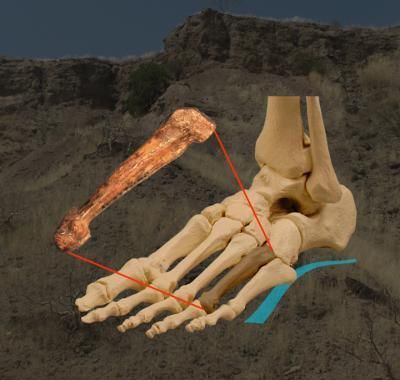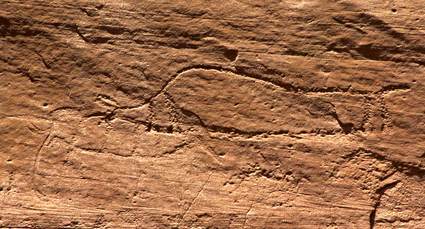
© Carol Ward/University of MissouriThis image shows the position of the fourth metatarsal Australopithecus afarensis (AL 333-160) recovered from Hadar, Ethiopia, in a foot skeleton.
A fossilized foot bone recovered from Hadar, Ethiopia, shows that by 3.2 million years ago human ancestors walked bipedally with a modern human-like foot, a report that appears Feb. 11 in the journal
Science, concludes. The fossil, a fourth metatarsal, or midfoot bone, indicates that a permanently arched foot was present in the species
Australopithecus afarensis, according to the report authors, Carol Ward of the University of Missouri, together with William Kimbel and Donald Johanson, of Arizona State University's Institute of Human Origins.
The research helps resolve a long-standing debate between paleoanthropologists who think
A. afarensis walked essentially as modern humans do and those who think this species practiced a form of locomotion intermediate between the quadrupedal tree-climbing of chimpanzees and human terrestrial bipedalism. The question of whether
A. afarensis had fully developed pedal, or foot, arches has been part of this debate. The fourth metatarsal described in the
Science report provides strong evidence for the arches and, the authors argue, support a modern-human style of locomotion for this species. The specimen was recovered from the Hadar locality 333, popularly known as the "First Family Site," the richest source of
A. afarensis fossils in eastern Africa, with more than 250 specimens, representing at least 17 individuals, so far known.


Comment: From the Superluminal Communication session dated 02 November, 1994:
Q: (L) Who were the original inhabitants of the city of Jericho?
A: Aramaic.
Q: (L) There was a stone tower at one of the lower levels, what was it built for?
A: Energy disbursement. Attempt to duplicate tower of Babel and Atlantean crystal towers.
Also read Origins of Agriculture - Did Civilization Arise to Deliver a Fix? to understand how introducing agriculture contributed to the gradual decline of our civilization.